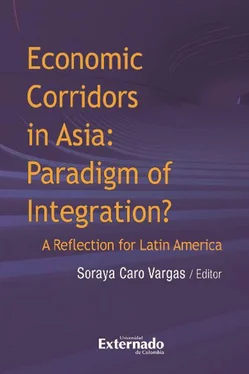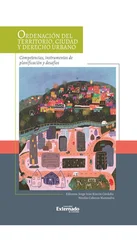Vov World. (1 de abril de 2018). Conferencia Cumbre de la Subregión del Gran Mekong emite Declaración Conjunta. Recuperado de: http://vovworld.vn/es-ES/noticias/conferencia-cumbre-de-la-subregion-del-gran-mekong-emite-declaracion-conjunta-632392.vov
WEBER, M. (2014). Escritos políticos. São Paulo: Editora Martins Fontes.
YIWEI, W. (2016). The Belt and Road Initiative. What Will China Offer the World In Its Rise. China: New World Press.
ZHOU, L. (2014). Los dilemas geopolíticos para la emergencia de China en el siglo XXI. Una posible salida a la búsqueda del poder marítimo en el mar del sur de China y el océano Índico a través del imaginario “String of Pearls”. En Observatorio de la Política China, IV Simposio Electrónico Internacional sobre Política China. Simposio llevado a cabo en España. Recuperado de http://politica-china.org/areas/seguridad-y-defensa/los-dilemas-geopoliticos-para-la-emergencia-de-china-en-el-siglo-xxi-una-posible-salida-a-la-busqueda-del-poder-maritimo-en-el-mar-del-sur-de-china-y-el-oceano-indico-a-traves-del-imaginario-stringAcceso 01/07/2018
2. INDIA’S ECONOMIC CORRIDORS AND SUB-REGIONAL CONNECTIVITY: CHALLENGES AND PROSPECTS
PANKAJ K JHA
India’s economic approach, particularly after adopting liberalized economic measures in the early 1990s, was aimed at liberalizing markets and promoting private investment and industrial production. In the last decade (2008-2018) the focus has been on building economic linkages and developing regional and intra-regional economic corridors, so that the benefits of development, trade and investment can reach a greater number of people. This would also promote consumption and employment. Furthermore, the Prime Minister, Narendra Modi had also proposed issues related to integrating manufacturing and production centers across India and also promoting development of small airports, ports and highway networks so that production and manufacturing can be accelerated. The proposals such as Security and Growth for All in the Region (under the acronym SAGAR) and also the integration of ports through Sagarmala (String for Oceans) within the country are aimed at envisaging India as one economic entity under similar development patterns. Among the other integrated highway networks, Golden Quadrilateral (connecting the four corners of the country through a highway network), river linking plan to promote inland waterways, and also sub regional integration with neighbors through the BCIM 1, India-Thailand, Myanmar Trilateral Highway network, BBIN 2transport network. Promoting the Special Economic Zones and Export Processing Zones includes developing Greenfield airports, dry inland ports, storage and warehousing facilities and the projection of a futuristic economic development plan. Additionally, the vision for integrating the Indian production centers as well as integrating regional value chains is meant to promote Indian exports and enhance border trade with the neighboring countries. This paper outlines the initiatives and the challenges that need to be addressed in this context.
Key Words: Economic Corridors, India, South Asia, Sub-regional Connectivity, Infrastructure.
El enfoque económico de la India, después de adoptar medidas de libertad económica a principios de la década de 1990, tenía como objetivo abrir el mercado, promover la inversión privada y la producción industrial. En la última década (2008-2018), el énfasis se ha puesto en la creación de vínculos económicos y en el desarrollo de corredores económicos regionales e intrarregionales, de modo que los beneficios del desarrollo, el comercio y la inversión puedan llegar a un mayor número de personas. Esto también promovería el consumo y el empleo. Además, el primer ministro Narendra Modi propuso temas relacionados con la integración de los centros de producción en toda la India y también el desarrollo de pequeños aeropuertos, puertos así como de vías para que la producción y la fabricación puedan acelerarse. Las propuestas como seguridad y crecimiento para todos en la región (con el acrónimo de Sagar) y la integración de los puertos a través de Sagarmala (cadena para los océanos) dentro del país, tienen como objetivo visualizar a la India como una entidad económica sin ningún patrón de desarrollo diferencial. Entre las otras redes de carreteras integradas, están: el Cuadrilátero Dorado (que conecta las cuatro esquinas del país a través de la red de carreteras), el plan de enlace fluvial para promover las vías fluviales y la integración subregional con los vecinos a través de la red de Carreteras Trilaterales de BCIM 3, India-Tailandia, Myanmar, Red de transportes BBIN 4. La promoción de zonas económicas especiales y zonas de procesamiento de exportaciones incluye el desarrollo de aeropuertos Greenfield , puertos secos interiores, instalaciones de almacenamiento, y proyecta un plan de desarrollo económico futurista. Además, la visión para integrar los centros de producción de la India, así como para integrarse en las cadenas de valor regionales, busca promover las exportaciones y mejorar el comercio transfronterizo con los países vecinos. El documento describe las iniciativas y los desafíos que deben abordarse en este contexto.
Palabras clave: corredores económicos, India, Sur de Asia, conectividad subregional, infraestructura.
Economic corridors are a means for promoting investment, optimally utilizing resources and accelerating economic development within the national and sub-regional geography. It can be functional through developing ports, highways, freight corridors and an efficient transportation system. The primary objective of economic corridors is to provide facilitating mechanisms for promoting competitiveness and efficiency which includes reduced distribution costs and addressing land procurement complexities. Economic corridors promote industrial development through identifying the underutilized zones and exploiting the potential to meet development challenges within a target region. Therefore, economic corridors are the lifelines of a nation’s growth capacity as well as a promotion plan for future exports. For India, which has had a socialist welfare economy since its independence, the last three decades have shown a slow transition to a liberal market economy. Therefore, for the growth of the manufacturing sector, economic corridors are prerequisites to long-term growth.
According to the Economic Survey of India 2017-2018, the services sector accounts for 54.40 per cent of India’s total Gross Domestic Product (GDP) while the industrial sector contributes 29.73 per cent followed by the agriculture and allied sector’s share of 15.87 per cent ( statisticstimes.com, n.d.). Economic corridors create the necessary foundation for the focused growth of manufacturing and production centers through facilitating measures such as tax breaks, cheap land and easy import procedures to set up the industrial zones. Furthermore, they create the necessary economic super structure with ancillary units and a seamless connectivity between centers of economic activity, so that maximum capital and labor efficiency can be achieved.
Therefore, the question arises as to whether India needs to focus at this juncture on economic corridors and the reasons for this. India has been witnessing a better than average growth of 6.5-7.5 per cent for the last five years (2014-2018) (IMF, 2018) and given this momentum, it has become imperative for India to explore its export-led industrialization possibilities and also facilitate Foreign Direct Investment (FDI) from both private and institutional investors. In the past, the common reasons for slow investment in India and also the concentrated FDI in select states, cities or Union territories such as Mumbai, Delhi, Bangalore, Chennai, Ahmedabad and Hyderabad attracting 75 per cent of total FDI ( Department of Industrial Policy and Planning, n.d.) was due to the comparative development pattern and ease of access to the resources and bureaucracy. This is because of a relatively better infrastructure as well as legal and other aspects which have made these regions a more preferred destination. In order to address this lopsided development, making the development of an infrastructure a priority as well as addressing the challenges involved with the environment, acquisition of lands and the time-bound process of development. . There has been due stress within the Indian establishment ( Niti Aayog, 2018) to integrate land use and infrastructure connectivity within India and its integration with its immediate neighbors ( NITI Aayog, 2015) as a means of benefitting the region and integrating India into sub-regional networks. India has been focusing not only at land-based physical infrastructure development but is giving due consideration to digital connectivity and maritime connectivity and has embarked on such projects with the Association of Southeast Asian Nations (ASEAN) and the Bay of Bengal Initiative for Multi-Sectoral Technical and Economic Cooperation (BIMSTEC) countries. Before discussing the role of economic corridors in the Indian context, it is important to evaluate it from a theoretical perspective.
Читать дальше












